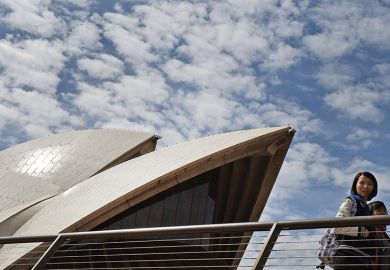Australian universities’ intake of students from China has flatlined, in a worrying sign for the nation’s third biggest export industry and the coffers of its most prestigious universities.
The number of Chinese people approved to study in Australian higher education institutions increased by 4.2 per cent in the second half of last year, compared with the equivalent period in 2016, according to the Department of Home Affairs.
However, the growth was exclusively among applicants who were already in Australia. The number of Chinese who successfully applied from overseas was unchanged, suggesting that Australia is now recycling its most lucrative students.
The department’s latest biannual report on student and temporary graduate visas also shows that, while overall student visa applications from Chinese people within Australia grew by 30 per cent, according to the new report, so-called offshore applications – from outside Australia – rose by just 6 per cent.
Across all nationalities, onshore applications for visas to study higher education increased by 24 per cent – almost 10 times the growth rate in offshore applications.
Foreigners who apply for student visas from inside Australia are usually tourists or working holidaymakers who decide to stay on and study, or overseas graduates seeking higher qualifications.
Neither of these explanations seems to explain the surging number of onshore applications from China. The report shows that tourists and holidaymakers usually opted to study English or vocational subjects, not higher education, and only a smattering of Chinese applicants were granted visas for postgraduate study.
A source cited reports of “poaching” of Chinese students, particularly by private vocational colleges. Under this scenario, foreigners obtain visas by applying to study at university – which is viewed relatively favourably by immigration officials – and then transfer to cheaper courses after arriving in Australia.
Chinese people still easily dominate the ranks of new student visa holders enrolling in higher education institutions. However, their share dropped from 39.7 per cent in the latter half of 2016 to 38.3 per cent a year later.
The statistics could inflame nerves about a possible crash in enrolments from the world’s biggest country. Relations between China and Australia have been strained by diplomatic tensions and a series of incidents at universities.
Last August, a University of Newcastle academic triggered outrage by referring to Taiwan and Hong Kong as “countries”, while a University of Sydney IT lecturer had to issue a public apology over a map of India that included territory claimed by China.
An Australian National University academic also apologised last year after translating a warning about cheating into Mandarin, while a Monash University lecturer was suspended over claims he had made fun of Chinese officials.
Such incidents have fuelled perceptions that the financial clout wielded by thousands of Chinese students, and the presence of Confucius Institutes at more than a quarter of Australian universities, is putting academic integrity at risk.
In possible responses, China has twice issued public safety warnings for its students in Australia, echoing a public relations nightmare that followed violent attacks against Indian students some years ago. Editorials in the Global Times, a Chinese Communist Party publication seen as a propaganda mouthpiece, have also questioned the value of Australian higher education.
More than 20 Chinese school visits to New South Wales have recently been cancelled, according to The Australian newspaper, while at least four high-level meetings between Australian vice-chancellors and senior Chinese education figures have been postponed.
Preparations are under way for Simon Birmingham, the Australian education minister, to visit China, while representative body Universities Australia plans to send a delegation of vice-chancellors in April.
They will be attempting to head off any move by Chinese authorities to limit the flow of students to Australia – a fate recently suffered by South Korea and Taiwan over the former’s deployment of a US missile shield system, and the latter’s independence activities.
Potentially a bigger fear is that Chinese would-be students will read the mood of their government, and unilaterally stop coming to Australia.
An analysis by The Australian last year concluded that 16 per cent of operating revenue at the University of Sydney, and 19 per cent at the University of New South Wales, came directly from the pockets of Chinese students.
Register to continue
Why register?
- Registration is free and only takes a moment
- Once registered, you can read 3 articles a month
- Sign up for our newsletter
Subscribe
Or subscribe for unlimited access to:
- Unlimited access to news, views, insights & reviews
- Digital editions
- Digital access to THE’s university and college rankings analysis
Already registered or a current subscriber?








